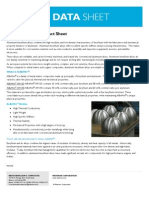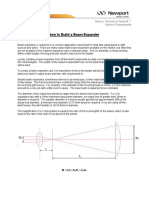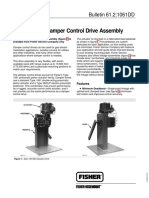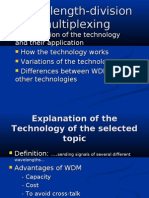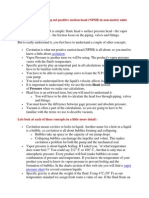Baader APO 95:560
Baader APO 95:560
Uploaded by
Parag MahajaniCopyright:
Available Formats
Baader APO 95:560
Baader APO 95:560
Uploaded by
Parag MahajaniOriginal Description:
Copyright
Available Formats
Share this document
Did you find this document useful?
Is this content inappropriate?
Copyright:
Available Formats
Baader APO 95:560
Baader APO 95:560
Uploaded by
Parag MahajaniCopyright:
Available Formats
Baader Apo
Travel Companion
A Top-Quality Grab-and-Go Crossover Apochromat
The amateur astronomer has a large choice of compact refractors today. Companies like William Optics, Takahashi, Stellarvue, Tele Vue, TMB, TEC and others offer short APOs in apertures ranging from 80 mm to 110 mm. Amateur astronomers often have to go on the move to find clear and dark skies and a small but excellent telescope can do wonders visually and photographically far from city lights. The champion between compactness and diameter is surely Astro-Physics with the legendary but elusive Stowaway 90 mm, a compact oiled-triplet APO offered for a time as an f/5, then as an f/7 instrument. The shortest one (actually with aperture of 92.5 mm f/4.9) is only 36-cm short and weighs 3 kilograms. Very few were produced: Roland Christen found it difficult to work with the central fluorite element of the triplet. Later, he found that even producing the f/7 was as expensive as making the 105-mm Traveler, and the Stowaways were discontinued,
By Andr Van der Elst
95/560 CaF2
Image 1 - The Baader Travel Companion mounted on the authors Vernonscope/Unitron alt-az mount.
much to the chagrin of many amateurs. If youre very lucky, you can sometimes find one of these little gems but at an as-
tronomical price! Ninety-five millimeters. That seems an odd diameter, but that may well be
Astronomy TECHNOLOGY TODAY
37
BAADER APO 95/560 CAF2 TRAVEL COMPANION
Image 2 - The Travel Companion is shipped in a heavy-duty plastic case (Outdoor Case) made by B&W International.
Image 3 - Disassembling the scope reveals a 60-mm-long tube extension.
the best aperture for a pocket-sized telescope for the traveling amateur astronomer. It gives enough resolving power for interesting views of the Moon and planets and enough light gathering power for deep-sky while maintaining capacity and light weight, even for airlinecabin storage. I have used, in the past, many 70-mm to 80-mm APOs, and Ive always been somewhat disappointed on the Moon and planets. A 100-mm APO is another story! It collects as much light as 125- to 150-mm catadioptrics, depending of the coatings
and obstruction of these instruments. But 100-mm APOs are or long, or heavy, or both. With 95-mm aperture, the fast Baader Travel Companion nears nicely the power of a 100-mm but with the physically dimension of most 80-mm short-focus refractors. Until now, in my opinion the only compact APO in the league of the Stowaway is the 92-mm f/5.5 Signature APO designed by the late Thomas Back (TMB Optical). But its weight is 4.3 kilograms. Now Baader Planetarium, the small but dynamic and innovative German com-
pany, offers the 95-mm Travel Companion, a short APO made 100 percent in Germany. I had an opportunity to test the prototype for several months and put it through its paces. Travel Case The refractor is shipped in a heavyduty plastic case (Outdoor Case) made by B&W International (Image 2). These cases have pressure-compensated valves and are made for extreme conditions. They are almost indestructible and can survive temperature between
SUBSCRIBE NOW!!!
BUY A FRIEND A GIFT SUBSCRIPTION!
TECHNOLOGY TODAY
ASTRONOMY
www.astronomytechnologytoday.com
38
Astronomy TECHNOLOGY TODAY
BAADER APO 95/560 CAF2 TRAVEL COMPANION
Image 4 - By unscrewing a 60-mm-long extension tube, the tube length is reduced to only 395 mm, allowing use of a binoviewer or a Herschel wedge without the need of additional transfer lenses.
Image 5 - The Steeltrack focuser is a black-anodized 50.8-mm (2.0-inch) Crayford type. The right knob has a 1:10 precision reduction gearing. The drawtube travel is 75 mm and the focuser features a scale graduated in millimeters and inches.
-40 and +80C and are completely airtight. There is room enough for several accessories. The Travel Companion itself is very well made and gives a feeling of solidity with its monolitic tube and a multitude of knife-edge diaphragms machined directly into the tube. It kills any erratic light without hampering the free airflow within the tube, avoiding turbulence to go into the light cone. With so many diaphragms machined inside the tube wall,
no wonder that the inside is the darkest Ive ever seen. No way to get stray light or reflections: its as dark as in a coalpit! Design and Construction The lens is a triplet APO with the central CaF2 (fluorite) element in contact by means of a thin oil film with the other two glasses. This gives only two airglass surfaces (like Zeiss, Astro-Physics and TEC). The oil is actually the same expensive and exclusive one as used by
Zeiss, matched perfectly to the fluorite index. The objective has the seven-layer Baader proprietary Phantom Group multi-coating with transmission optimized for 520 nm. All this keeps haze to an absolute minimum: the glass seems to disappear with this seemingly invisible coating! The optical tube is 455 mm long, including the focuser (540 mm with extended dew shield). But by unscrewing a 60-mm-long extension tube (Image 3),
RiDK Series: Riccardi Dall-Kirkham
The RiDK Series represents the new reference point for all modified Dall-Kirkham instruments. The innovative optical design can deliver an edge of the field RMS spot size under 3 micron, in a beautiful, compact and superbly manufactured instrument. With more than 60mm of 380-2000 nm diffraction limited flat field, the RiDK 305 (305mm f/7.9) is an example of the ultimate astroimaging or even visual telescope for whoever desires just the best for all the deep sky wonders. RiDK si available also in 400mm and 500mm diameter.
RiDK: R iDK: THE ULTIMATE ULTIMATE UL
GALLERY GALLER Y
www w. .officinastellare.com
TELESCOPE !
OS F Flagship lagship g D Dealers ealers in USA: A: www.bisque.com b www.optcorp.com www.telescopes.net w ww.bisque .com - www.nmsouthernskies.com www.nmsout thernskies.com - w ww.optcorp.com - w ww.telescopes.net
Astronomy TECHNOLOGY TODAY
39
BAADER APO 95/560 CAF2 TRAVEL COMPANION
Image 6 - The Travel Companion ships with sturdy mounting rings threaded for dovetails from Astro-Physics, Vixen, Skywatcher, and the like. The rings have a flat top with other threads permitting connecting accessories.
Image 7 - The baffle configuration of the optical tube are continued throughout the entire length of the dew shield.
this is reduced to only 395 mm. In this configuration, one can use a binoviewer or a Herschel wedge without the need of additional transfer lenses (Image 3). The diameter of the OTA is 99 mm (dew shield is 110 mm) and the weight only 3.1 kilograms. The Baader-designed Steeltrack focuser is a black-anodized 50.8-mm (2.0inch) Crayford type (Image 4). Its ready for motorized operation. The right knob has a 1:10 precision reduction gearing. The drawtube travel is 75 mm, and the focuser features a scale graduated in millimeters and inches. It too has extensive knife-edge baffling. Three clamp knobs in 120 degree distance extend pressure against a bronze compression ring on a star diagonal and other accessories. A large locking ring with three chrome grip levers permits easy rotation of the focuser. The precision ball bearings ride on hardened and polished stainless-steel rods inset into the aluminum drawtube. This gives a buttery-smooth motion with almost no feeling of friction. If you think the celebrated Feather Touch is smooth and it is try this one! As a note: the
Steeltrack focuser is available for other refractors, Newtons and catadioptrics of most brands. A new short 50.8/31/75mm Click-Lock reducing ring clamps all accessories with a gentle twist without marring them. For mounting the OTA, Baader offers a pair of sturdy rings threaded for dovetails from Astro-Physics, Vixen, Skywatcher, and the like (Image 5). The rings have a flat top with other threads permitting connecting accessories on the Travel Companion (guide-scope, finder, etc). Mounting the scope with the provided pair of rings via an 8-inch AstroPhysics sliding bar on my Vernonscope/Unitron Alt-Az mount from my earlier Brandon 94-mm f/7 APO is straightforward. The telescope is easily balanced (it is half as long as the Brandon) and after removing the aluminum cover, the captive dew shield glides smoothly in place. The dew shield has generous length, and I never experienced fogged optics. I compared the Travel Companion for several months with my APQ 100/640 and a 90-mm f/5 Stowaway.
Like always when I have a new telescope to test, I was clouded out for several weeks! But clouds are not a problem for daytime tests. Daylight Observations Nature observing shows immediately that this small scope is a very high-quality apochromat. Even a bright reflection of the sun on a window gives no trace of false color. A nearby tree (at this short distance, the air is calm) shows a wealth of small contrasty details exquisitely sharp up to 280x with an Abbe 4-mm and Zeiss 2x Barlow. There is no image breaking down at even higher magnification, just loss of light. It surprised me that this 95-mm apo gives brighter images than the 92.5-mm Stowaway, despite the minimal difference in diameter. The difference is small but noticeable, nonetheless. That is the result of Phantom Coating, the special oil, and the fluorite element that put the light where it belongs: in the image. No internal glare or ghosts, but a clean high contrast image. The baffling (Image 6) is a far cry from the one and only baffle in
40
Astronomy TECHNOLOGY TODAY
BAADER APO 95/560 CAF2 TRAVEL COMPANION
the APQ OTA! In short, the Travel Companion is a perfect spotting scope or long-distance microscope for nature study and photography when mounted on a sturdy tripod with pan-head. When the skies eventually cleared, I checked a bright white star image inside and outside the focus. Star images are almost perfect just a small hint of green on intra-focal and orange on extra-focal images at 140x with an Abbe 4-mm. This is very close to what my reference Zeiss APQ 100/640 shows, but the later has an f/6.4 focal ratio, not f/5.9. Vega and Venus are clean white when focused in both scopes. But there is an important difference between the APQ and the Travel Companion: While the APQ requires a prism star diagonal to obtain perfect achromatism, the Travel Companion needs a mirror star diagonal.
Image 8 - This image was captured through the Travel Companion using a Baader Herschel wedge.
Sizes for SBIG, QSI, FLI Durable to extreme weather fluctuations Non-reflective 20+ years of thin film design Manufactured in Vermont
Astronomy TECHNOLOGY TODAY
41
BAADER APO 95/560 CAF2 TRAVEL COMPANION
discs surrounded by a very faint first ring. The Dawes limit for this aperture is 1.2 arcseconds bringing many interesting doubles in its reach. The beautiful Double Double in Lyra is easy at 93x using an Abbe 6-mm, while the colorful Epsilon Bootes (magnitude 3 and 6.3, 2.8 arcseconds separation) splits nicely at 140x. The next target, the binary Lambda Ophiuchi (magnitude 4.1 and 5.1) is more difficult with only 1.4 arcseconds between the components Image 9 - We dont normally associate fast apos with in 2012. This binary needs high-resolution planetary imaging, but the Travel pushing further to 187x, 224x Companion holds its own nonetheless. and 280x to be clearly split. The two white stars of Pi Aquilae Observing Doubles (magnitude 6.3 and 6.8) have a 1.4 arcThe Travel Companion is a nice inseconds separation. The pair is elongated strument for double and multiple star at 70x, just split at 112x and even better observers. Stars are textbook-sharp airy when switching to 160x. Higher magnifications up to 364x give a clean split with a dark separation between the components, confirming that the resolving power of this instrument can be easily attained. Delta Cygni is another binary of unequal brightness (magnitude 2.9 and 6.3) and the companion lays just on the first ring at 160x. The current separation is 2.7 arcseconds. Despite my brightly illuminated Brussels sky, I could detect component E, the fifth star in the Orion Trapezium at 140x in steady seeing. No doubt that F would also be visible under darker skies. My naked eye limit is about magnitude 4. That means deep-sky observing is poor where I live. Anyway, this shortfocus APO will give impressive images and pictures of the most popular objects under dark skies, thanks to the very transparent fluorite glass, only two air-
42
Astronomy TECHNOLOGY TODAY
BAADER APO 95/560 CAF2 TRAVEL COMPANION
glass surfaces, and very high-transmission coatings. Actually, when shining through the lens with a green laser, you cant see the fluorite element! Deep-Sky Views With only 560-mm focal length, a Panoptic 41mm wide-field eyepiece gives 14x and an expansive rich field of almost 5 degrees, for an exit pupil of 6.9 mm. With such a wide field, a finder is not really necessary. The large fields provided by those 2-inch widefield eyepieces in the 30- to 40-mm focal range are fantastic for large deep-sky objects like the Andromeda and M33 galaxies, the Pleiades, the Double Cluster in Perseus and other large, bright open clusters, etc. Because of the fast optics, modern highly corrected wide and ultra-wide eyepieces are best suited to get flat fields sharp to the edge. The high light transmission and contrast gives impressive images of globular clusters and planetary nebulae as well. The brightest globulars
Image 10 - The Travel Companion manages impressive image scale as evidenced by the detail in this lunar image.
Baader Classic Q-Turret Eyepiece Sets
The four Classic Eyepieces, Q-Barlow, and Q-Turret form a complete set of high quality eyepieces that deliver an extensive range of instantly accessible focal lengths (2.7mm, 4.6mm, 6mm, 8mm, 10mm, 14mm, 18mm, 32mm). With foam fitted box only $399!
Hundreds of Other Accessories in Stock!
www.alpineastro.com
Astronomy TECHNOLOGY TODAY
43
BAADER APO 95/560 CAF2 TRAVEL COMPANION
ter diameter, 670-m deep) is easy at 160x and 187x. Aldrin (3.4 kilometer) and Collins (2.4 kilometer) are at the limit of this scope but just visible by steady seeing and the right illumination. The resolving power of a 95-mm telescope on the Moon is about 2.4 kilometers. Moon, Sun and planets are even more impressive with a binoviewer in combination with a Barlow lens or, even better, with Baaders own FFC quadruplet lens. By removing the 60-mm extension tube, focus can still be reached with the Grossfeld bino and Baader 2inch Herschel wedge. This combination, plus a polarizing filter on each eyepiece, will provide the best views ever of sunspots, faculae and granulation! Freezing Refractors I was curious about the behavior of the Travel Companion under freezing conditions. Many APOs I tested in the past are better in the summer than in the winter! One could heat the lens elements, but it is better that a refractor perform at temperature extremes without need of such measures. No APQs, even the large 150-mm, ever showed image deterioration in the winter. No wonder: Zeiss tested their lenses ten years in harsh conditions (centrifugal forces in all directions, wide range of temperatures differences, even in a vacuum chamber down to 1/10 atmosphere!) to come up with a cell design and an oil that would not shrink or freeze at considerable low temperatures. Baader has tested the objective of the Travel Companion in a cold chamber down to -50C and uses the same oil. No wonder, again, that the images remain perfect under my lighter freezing conditions! Astrophotography I gave the Travel Companion and the dedicated photographic 2-inch Field
Image 11 - In this image of the stellar field surrounding M27, the Travel Companion generated nice, round stars from corner to corner.
begin to resolve even under my Brussels sky at higher magnification. Solar System Observations Despite its modest size, this APO shows a wealth of details on Jupiter and Saturn. The sky background is jet black right up the edge of the planetary discs. With the right planetary eyepieces there is no scatter of light. The ringed planet was unfortunately low above the horizon in 2012, but the images are sharp and contrasty at 140x, 160x (Pentax Ortho 7mm + Zeiss Barlow) and 187x (Abbe 6mm + Zeiss Barlow). Jupiter presents a magnificent sight. The belts are sharply delineated at 112x (Pentax XO 5-mm) and 140x, and colors, serrations, loop festoons, dark clumps, small spots are clearly visible at 160x and 187x. The Great Red Spot is easy with some detail in it. The Jovian moons are tiny disks with different color hues. The shadows during transits are coal black. All this is a far cry from what you see in many popular small catadioptrics in the 89-mm to 102-mm aperture range, whatever
their price. Lunar details are breathtaking at high powers, again with the sky background very dark up to the edge of the lunar disc, something that will please lunar occultation observers. Magnification can be pushed up to 280x without image breakdown on this bright object. The narrow rille Rima Birt near the Straight Wall is clearly defined and irregular at 160x, ending in a small shallow dome-like feature. Many fine rilles are in the reach of this APO. Even the more difficult ones near Prinz begin to show. The Hadley rille where Apollo 15 landed is easy. The rille complex near Ramsden is also an interesting target, rimae I, III and V being easy and hints of some parts of rima II. The large formation Ptolemaeus reveals at least half a dozen shallow depressions depending on illumination and as many craterlets, A, D, M, S and C being the easiest. The difficult rille near the wall begins to show. In the landing area of Apollo 11 in Mare Tranquilitatis, a few craterlets were named after the first lunar explorers. Armstrong (4.6 kilome-
44
Astronomy TECHNOLOGY TODAY
BAADER APO 95/560 CAF2 TRAVEL COMPANION
Flattener for a few weeks to Bart Declercq, one of the best astrophotographers in Belgium. (See Images 8-12.) He too praises the mechanics of this very solid refractor, with really smooth and accurate focuser. The only annoyance is that when releasing the screw to allow rotation of the focuser, the image shifts several arc minutes. Tightening the screw again does re-center the image perfectly, but when framing an object, one doesnt want to have to tighten it every time to check if the position is correct. Some shift is acceptable, but it is too much. The high-resolution Jupiter, Moon and solar images are very significantly better than with an 80-mm apo with which we compared the Travel Companion. The provided Field Flattener is perfectly tuned, and the test images show pin-point stars anywhere in the field of view of Barts APS-C sized Canon 60D. The weather circumstances during the tests prohibited really long series of exposures, so it is hard to comment on the stability of the focus over longer periods of time. But, from the feel of the focuser and the sturdy tube, it would be very surprising if it is less than excellent with no fear of flex-issues. Conclusion In summary, the Travel Companion is a top-quality grab-and-go crossover apochromat, well thought out and a joy
Image 12 - Few instruments are better at producing rich fields of view than small, fast apos, as demonstrated by this image capturing M31, M32 and M110 in a single frame.
to use. Its an awesome richest-field telescope and capable of high resolution, high power views, as well. Its performance is very close to that of my Zeiss APQ 100/640, only in a much shorter and modern package with much better baffling and modern focuser. All that and for a much lower price (the APQs are no longer in production and are collector items). However, some people thought the transport case too large and heavy when I showed the scope at club meetings. The B&W case is great and surely the most secure way to protect this fine instru-
ment, but may be overkill for many amateurs. A soft bag, like the one of the Stowaway, would increase the appeal and versatility of the Travel Companion and would have no problem qualifying as airline carry-on luggage. A padded shoulder bag and a slimmer, lighter pair of rings (or a short, fixed dovetail bar like on the APQ) would also make this compact APO an even more-perfect go-anywhere/anytime instrument. It would be more attractive to amateurs traveling light and demanding portable performance in the spirit of the original Stowaway.
A big Dob on an Equatorial Platform is the ultimate observing machine. The Platform gives you precision tracking, whether you are observing with a high-power eyepiece, imaging with a CCD camera,or doing live video viewing with a MallinCam. Just check out this image of NGC3628 taken by Glenn Schaeffer with a 20-inch Dob on one of our Aluminum Platforms!
Visit our website for details about our wood and metal Equatorial Platforms, as well as our line of large-aperture alt/az SpicaEyes Telescopes. You can also call or email for a free color brochure.
274-9113 tomosy@nccn.net EQUATORIAL PLATFORMS (530) www.equatorialplatforms.com
Astronomy TECHNOLOGY TODAY
45
You might also like
- Wiley - Fabrication Methods For Precision Optics - 978-0-471-70379-2Document1 pageWiley - Fabrication Methods For Precision Optics - 978-0-471-70379-2Michal SlavNo ratings yet
- Remote Start Cable IR2259Document3 pagesRemote Start Cable IR2259rully alphasainsNo ratings yet
- SatspecsDocument1 pageSatspecsRgonz79100% (1)
- SUNOPTICS: Manually Venting Double Hip, Pyramid and Flat SkylightsDocument2 pagesSUNOPTICS: Manually Venting Double Hip, Pyramid and Flat SkylightsvladrvladrNo ratings yet
- BCN3D Moveo BOM For Proto-PlantDocument10 pagesBCN3D Moveo BOM For Proto-PlantCristian FloresNo ratings yet
- Optical LED Intensity Control 808AEDocument6 pagesOptical LED Intensity Control 808AEBanani Acharya100% (1)
- FAR2137S BB 2837S Installation Manual L 4-12-11 PDFDocument123 pagesFAR2137S BB 2837S Installation Manual L 4-12-11 PDFtariktunadNo ratings yet
- Zebra Current Capacity Calculation SheetDocument1 pageZebra Current Capacity Calculation Sheetbinode100% (2)
- Fastmax 180 F4.5: Limited Edition Maksutov-Newtonian by Astro-PhysicsDocument4 pagesFastmax 180 F4.5: Limited Edition Maksutov-Newtonian by Astro-Physicsmohamadazaresh100% (1)
- Lacey Thacker TutorialDocument10 pagesLacey Thacker TutorialWilliam Pinto HernándezNo ratings yet
- Hamamatsu PMT Catalog-HandbookDocument48 pagesHamamatsu PMT Catalog-HandbookGuillermo CalderónNo ratings yet
- KLP 2780 PG1Document1 pageKLP 2780 PG1Batzorig RegzenNo ratings yet
- Programat P300-G2Document36 pagesProgramat P300-G2Dreptu MariusNo ratings yet
- Triton-Ocean Bottom Seismometer-001Document2 pagesTriton-Ocean Bottom Seismometer-001Furio RuggieroNo ratings yet
- Соеденители ENG 2010Document578 pagesСоеденители ENG 2010wagospbNo ratings yet
- OLYMPUS Stream Software PDFDocument20 pagesOLYMPUS Stream Software PDFFALRepresentaionesNo ratings yet
- MAAB-032 AlBeMet Technical Data SheetDocument11 pagesMAAB-032 AlBeMet Technical Data SheetKillgus100% (1)
- Defence Space Optics BrochureDocument4 pagesDefence Space Optics BrochureRavishankarNo ratings yet
- CR39 50yearsDocument40 pagesCR39 50yearsaristos58No ratings yet
- Flyback Plasma Speaker With 555Document5 pagesFlyback Plasma Speaker With 555Ciro GiordanoNo ratings yet
- How To Measure MTFDocument64 pagesHow To Measure MTFamtcorporationNo ratings yet
- Pedestrian Visibility Under Automobile Low-Beam Headlight IlluminationDocument1 pagePedestrian Visibility Under Automobile Low-Beam Headlight IlluminationFlorin RusitoruNo ratings yet
- Mil STD 1580B - CHG 2 PDFDocument134 pagesMil STD 1580B - CHG 2 PDFrenatobellarosaNo ratings yet
- MIT Rocket Team Fin Flutter ResearchDocument25 pagesMIT Rocket Team Fin Flutter ResearchRandy WigginsNo ratings yet
- StahlHazLocElProdCat PDFDocument134 pagesStahlHazLocElProdCat PDFbakien-can100% (1)
- Iso 10110Document18 pagesIso 10110edNo ratings yet
- Mitutoyo Objective CatalogDocument32 pagesMitutoyo Objective Catalogilanben2003No ratings yet
- Quiz - Solution - Design A SingDocument9 pagesQuiz - Solution - Design A SingPaulNo ratings yet
- Circular Blade X CutDocument2 pagesCircular Blade X CutSankar KrishnanNo ratings yet
- Tds tc-1 eDocument6 pagesTds tc-1 eMohit SharmaNo ratings yet
- Observation of Zenneck-Like Waves Over A Metasurfa PDFDocument6 pagesObservation of Zenneck-Like Waves Over A Metasurfa PDFgospodarmunjaNo ratings yet
- Jetson Agx Xavier Platform Adaptation and Bring-Up GuideDocument41 pagesJetson Agx Xavier Platform Adaptation and Bring-Up GuideafdgtdsghfNo ratings yet
- AUTO 306 Vacuum Coater Volume 2 - Operating InstructionsDocument52 pagesAUTO 306 Vacuum Coater Volume 2 - Operating Instructionsregulus7100% (1)
- D0249611-6 - # - en - # TD Input ImpedanceDocument7 pagesD0249611-6 - # - en - # TD Input Impedanceathanasios galazoulasNo ratings yet
- How To Make Rock Thin Sections, Without Much Equipment - How - To - Make - Rock - Thin - SectionsDocument2 pagesHow To Make Rock Thin Sections, Without Much Equipment - How - To - Make - Rock - Thin - SectionstwinscrewcanoeNo ratings yet
- Analysis and Design of Nano AntennaDocument163 pagesAnalysis and Design of Nano AntennaSaidatul NorlyanaNo ratings yet
- Classification of Filters Based On Eurovent StandardDocument2 pagesClassification of Filters Based On Eurovent Standardnareshbv749No ratings yet
- Datasheet P700 Power OptimizerDocument2 pagesDatasheet P700 Power OptimizerCléber de LimaNo ratings yet
- Type 585 and 585R Size 100 Piston Actuators: Bulletin 61.2:585Document18 pagesType 585 and 585R Size 100 Piston Actuators: Bulletin 61.2:585Datt NguyenNo ratings yet
- Dxe-3x10 SNDocument20 pagesDxe-3x10 SNpu2kgp100% (1)
- A Comprehensive Analysis On The State-Of-The-Artdevelopments in Reflectarray, Transmitarray, and Transmit-Reflectarray AntennasDocument22 pagesA Comprehensive Analysis On The State-Of-The-Artdevelopments in Reflectarray, Transmitarray, and Transmit-Reflectarray AntennasZohre NoamadeNo ratings yet
- Optical Solutions For The AUG Assault RifleDocument2 pagesOptical Solutions For The AUG Assault Rifleakms1982No ratings yet
- Aiwa CSD Td10Document48 pagesAiwa CSD Td10Juan Pablo Montoya Cardenas100% (1)
- Surface Texture Measurement With JenoptikDocument12 pagesSurface Texture Measurement With Jenoptikgraziano girottoNo ratings yet
- Lc-32le350m enDocument70 pagesLc-32le350m encandraNo ratings yet
- Iris Valves Pharma Design: FluidtecqDocument2 pagesIris Valves Pharma Design: FluidtecqmehtahemalNo ratings yet
- Mto Ev005 Tb67s109aftgDocument7 pagesMto Ev005 Tb67s109aftgTrịnh Thanh TàiNo ratings yet
- Anatomy of Surface WavesDocument7 pagesAnatomy of Surface WavesTom SebastianNo ratings yet
- Becuri MicroscopDocument44 pagesBecuri MicroscopsambadeeNo ratings yet
- The Iris DiaphragmDocument8 pagesThe Iris DiaphragmRandy WigginsNo ratings yet
- Beam ExpanderDocument12 pagesBeam ExpanderRio Ananda PutraNo ratings yet
- 12th WorkshhetsDocument24 pages12th WorkshhetsAtul VermaNo ratings yet
- LaserDocument72 pagesLaserVinay PrakashNo ratings yet
- LFW 20121001 Oct 2012Document80 pagesLFW 20121001 Oct 2012Orlando BarriosNo ratings yet
- Type 1061DD Damper Control Drive AssemblyDocument6 pagesType 1061DD Damper Control Drive AssemblyDatt NguyenNo ratings yet
- Air BearingsDocument13 pagesAir BearingsRohith RavindranathNo ratings yet
- The Dark Side of The Conjugate Match (Archive) - QRZ ForumsDocument101 pagesThe Dark Side of The Conjugate Match (Archive) - QRZ ForumsKate Ebneter100% (1)
- Microscope Design and Construction - Payne (1957)Document203 pagesMicroscope Design and Construction - Payne (1957)noname nonameNo ratings yet
- 06 CatalogDocument136 pages06 CatalogjaumegusNo ratings yet
- At130 Story Att 7jan12Document11 pagesAt130 Story Att 7jan12Max CorneauNo ratings yet
- Folder ASA-Astrographen EDocument4 pagesFolder ASA-Astrographen EAudrey RussellNo ratings yet
- Work Life BalanceDocument8 pagesWork Life BalanceMurali KhanNo ratings yet
- Your Future Is Your Fault: Learning To Think BigDocument16 pagesYour Future Is Your Fault: Learning To Think BigParag MahajaniNo ratings yet
- Wisdom StoriesDocument78 pagesWisdom StoriesParag MahajaniNo ratings yet
- Women and SunsignDocument26 pagesWomen and SunsignParag MahajaniNo ratings yet
- Word ListDocument7 pagesWord ListParag MahajaniNo ratings yet
- Taiwan NTUT - Emerging Technology Development For Multimedia Communications - 11!13!2006Document47 pagesTaiwan NTUT - Emerging Technology Development For Multimedia Communications - 11!13!2006Parag MahajaniNo ratings yet
- WDMDocument16 pagesWDMParag MahajaniNo ratings yet
- FirstWorld PpsDocument17 pagesFirstWorld PpsManish TiwariNo ratings yet
- DTMF and KPMLDocument19 pagesDTMF and KPMLParag MahajaniNo ratings yet
- Historical Overview of Optical NetworksDocument34 pagesHistorical Overview of Optical NetworksParag MahajaniNo ratings yet
- Chapter 7Document9 pagesChapter 7Parag MahajaniNo ratings yet
- Cloud Computing For The Enterprise, Part 3: Using WebSphere CloudBurst To Create Private CloudsDocument12 pagesCloud Computing For The Enterprise, Part 3: Using WebSphere CloudBurst To Create Private CloudsYakura Coffee100% (2)
- Expert Panel Vikas GiridharDocument4 pagesExpert Panel Vikas GiridharParag MahajaniNo ratings yet
- Introduction To EnzymesDocument6 pagesIntroduction To EnzymesHamsa EhsanNo ratings yet
- Transport of Particles in Liquid Crystals: Oleg D. LavrentovichDocument20 pagesTransport of Particles in Liquid Crystals: Oleg D. LavrentovichAdya ViraNo ratings yet
- NPSHDocument15 pagesNPSHnamlidjordieNo ratings yet
- Vector Test-2016 PDFDocument2 pagesVector Test-2016 PDFimranNo ratings yet
- Thrust Restraint Design For DI PipeDocument24 pagesThrust Restraint Design For DI PipeRoshan FazyNo ratings yet
- Ad IiDocument95 pagesAd IiRaahini IzanaNo ratings yet
- SAT Mathematics (With Calculator) Practice Test 4 - Assistive TechnologyDocument47 pagesSAT Mathematics (With Calculator) Practice Test 4 - Assistive TechnologyApexx LegendsNo ratings yet
- 13S1 FE1073 C1-Resultants and Equilibrium of ForcesDocument12 pages13S1 FE1073 C1-Resultants and Equilibrium of ForcesglenlcyNo ratings yet
- CHAPTER 9 Electronics 2015Document8 pagesCHAPTER 9 Electronics 2015Pikachu AlsalehNo ratings yet
- Absolute MagnitudeDocument14 pagesAbsolute MagnitudeGregor SamsaNo ratings yet
- Alta Mimi 2015Document11 pagesAlta Mimi 2015Félix Gallo CruzNo ratings yet
- John Titor FaxesDocument18 pagesJohn Titor FaxesRoberto ZepedaNo ratings yet
- Projection of LinesDocument7 pagesProjection of LinesMangam Rajkumar0% (1)
- Organic Chemistry 11 IscDocument25 pagesOrganic Chemistry 11 Iscsg8558054No ratings yet
- CMOS 1.8GHz VCODocument4 pagesCMOS 1.8GHz VCOsanjeevsoni64No ratings yet
- Magnetostatics PDFDocument63 pagesMagnetostatics PDFShashank KrrishnaNo ratings yet
- Chapter4analysis of Clamping ForceDocument10 pagesChapter4analysis of Clamping ForceMohammad umarNo ratings yet
- 5070 w10 QP 12Document20 pages5070 w10 QP 12mstudy123456No ratings yet
- Spectrophotometric Determination of Iron With Orthophenanthroline PDFDocument5 pagesSpectrophotometric Determination of Iron With Orthophenanthroline PDFribotsNo ratings yet
- Total Internal ReflectionDocument26 pagesTotal Internal ReflectionPradeepNo ratings yet
- Adiabatic Reactor 2Document11 pagesAdiabatic Reactor 2luis manuel peñalver maldonadoNo ratings yet
- Fall2015 PHY1321 EXAM No AnswersDocument10 pagesFall2015 PHY1321 EXAM No AnswersQasim Ali MuhammadNo ratings yet
- 10 Grant 151-06Document1 page10 Grant 151-06Mike CedersköldNo ratings yet
- Transformer Tranning PPT by VijayDocument19 pagesTransformer Tranning PPT by VijayVijay KaplsyaNo ratings yet
- 12th Grade Chemistry by Byju'sDocument54 pages12th Grade Chemistry by Byju'srohan rajNo ratings yet
- CBSE Class 12 Chemistry - Alcohols, Phenols and Ethers AssignmentDocument14 pagesCBSE Class 12 Chemistry - Alcohols, Phenols and Ethers AssignmentmaheshNo ratings yet
- Welding Research: Failure Investigation of Eddystone Main Steam PipingDocument10 pagesWelding Research: Failure Investigation of Eddystone Main Steam PipingrekyNo ratings yet
- 23 - Electric Potential - R K ParidaDocument9 pages23 - Electric Potential - R K ParidaMonicaNo ratings yet
















